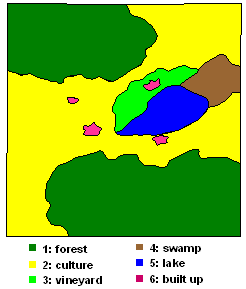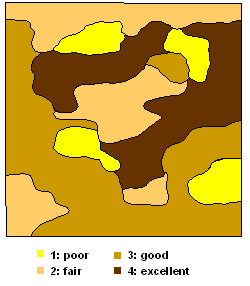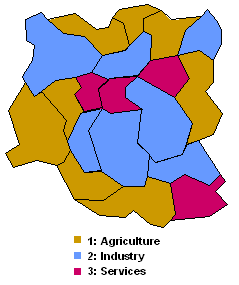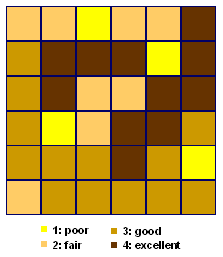Introduction to unit Spatial Dependency
The question of the dependency is thus more complex to formulate
in the case of predefined objects resulting from a spatial division.
There are two distinct situations:
- The considered spatial features are
resulting of
the spatial distribution of properties of the phenomenon which
one wishes to describe:
- Example 1 (features produced by the distribution of landcover
types; see Fig 2.2a):
In this situation, the spatial dependency is absent by definition,
the contiguous neighbours of each feature have different properties.
These properties are
categories expressed numerically at a
nominal scale, for
which only the identity or the difference has a meaning.
- Example 2 (features produced by the distribution of the classes of soil
quality for agriculture; see Fig 2.2b):
Numerical properties of features express hierarchical
position in the scale of aptitude, their contents are thus described
as being of “ordinal” level.
It is thus relevant to describe the way in which the level of soil quality varies
according to the space.
|
Discontinuous spatial distributions for resulting features
| Resulting spatial features |
Resulting spatial features |
|
|
|
| Fig 2.2a: Landcover categories (nominal scale) |
Fig 2.2b: Units of aptitude for agriculture (ordinal scale) |
Figure 2.2 |
|
- The considered spatial features are defined a priori and one wishes to describe
the spatial distribution of their properties for another particular phenomenon:
- Example 3 (the spatial distribution of the major economical
sector for administrative features such as the "districts" of
a study area; see Fig 2.3a): In this situation, the spatial
dependency can exist for a phenomenon measured on a nominal
level because the properties are not necessarily related to the
nature of the spatial features. Thus, the contiguous neighbours
of each object "district" can have identical properties.
- Example 4 (spatial features produced by the distribution
of classes of aptitude for agriculture of soil units; see Fig 2.3b):
The numerical properties of the features express
hierarchical position
on a scale of soil quality, but their contents are thus of
ordinal level level.
It is then relevant to describe the way in which the level
of quality varies according to the spatial proximity.
|
Discontinuous spatial distributions for predefined features
| Predefined spatial features (districts) |
Predefined spatial features (cells) |
|
|
|
| Fig 2.3a: Categories of major economic sector (nominal scale) |
Fig 2.3b: Units of soil quality for agriculture (ordinal scale) |
Figure 2.3 |
|
Thus, one can summarize the various situations in the following way:
- When the considered spatial features
result from a spatial distribution
of the properties of the phenomenon to be described, the spatial
dependency (spatial autocorrelation) can exist only when this phenomenon
is described on an ordinal level. The values of their properties are
called classes.
- When the considered spatial features are
a priori defined, they are independent
of the spatial distribution of the phenomenon. A spatial dependency can
thus exist, whatever the level of measurement of the phenomenon (nominal,
ordinal or cardinal), it will be thus possible to describe it.




